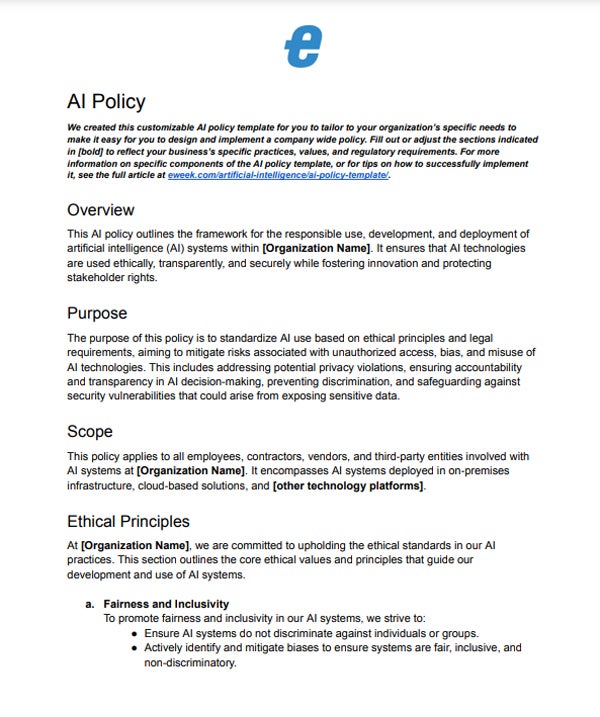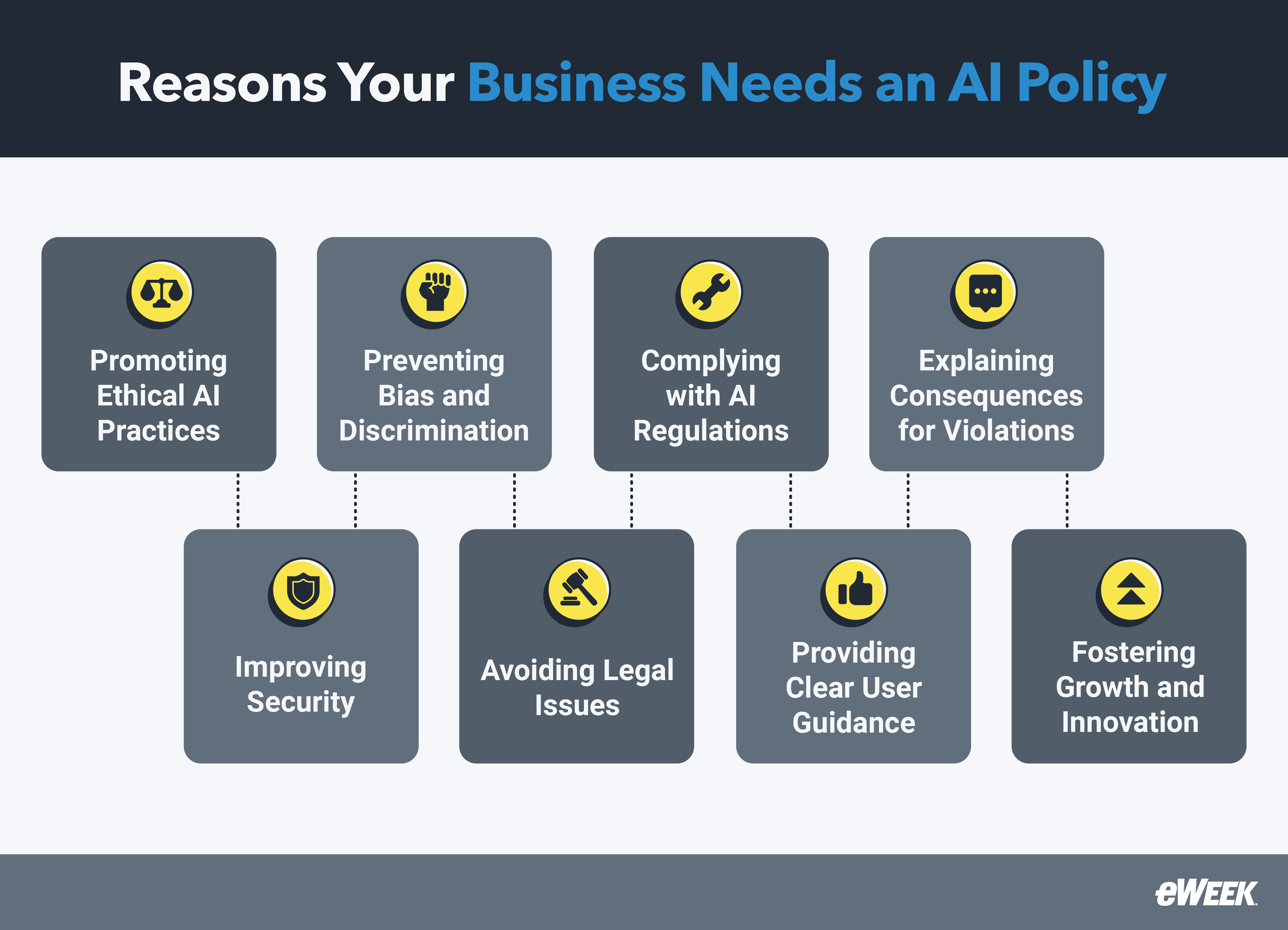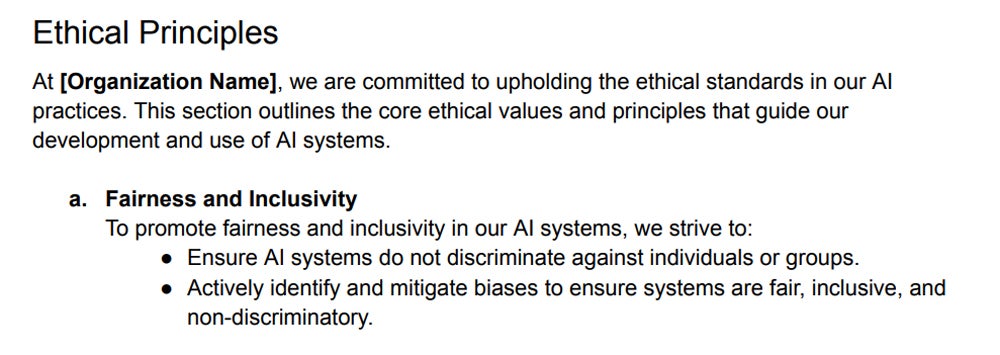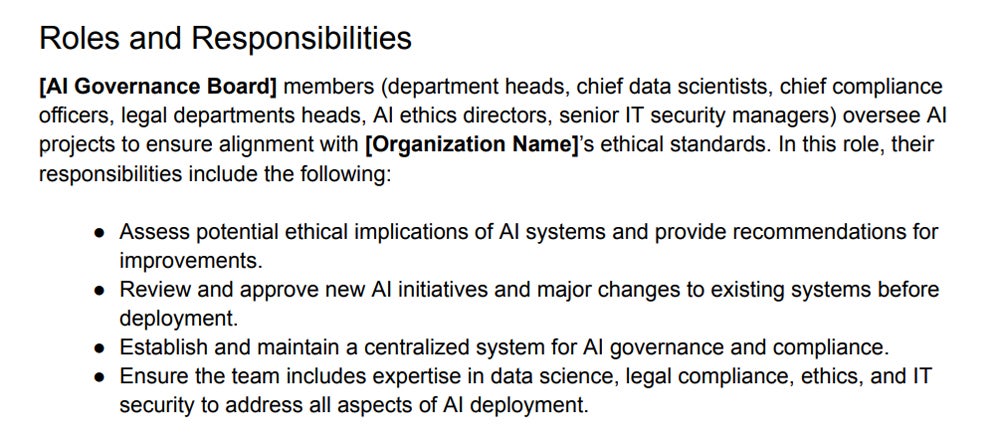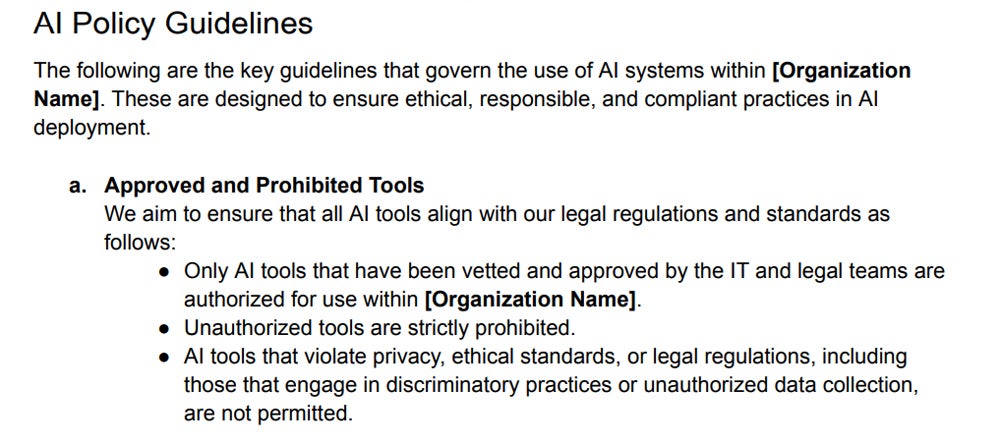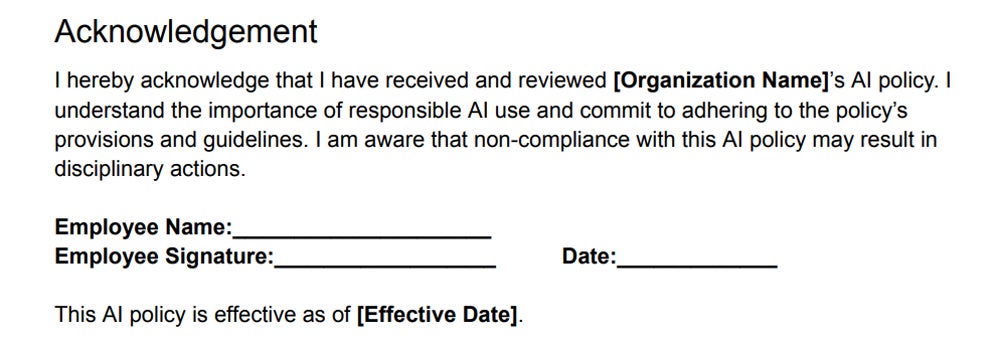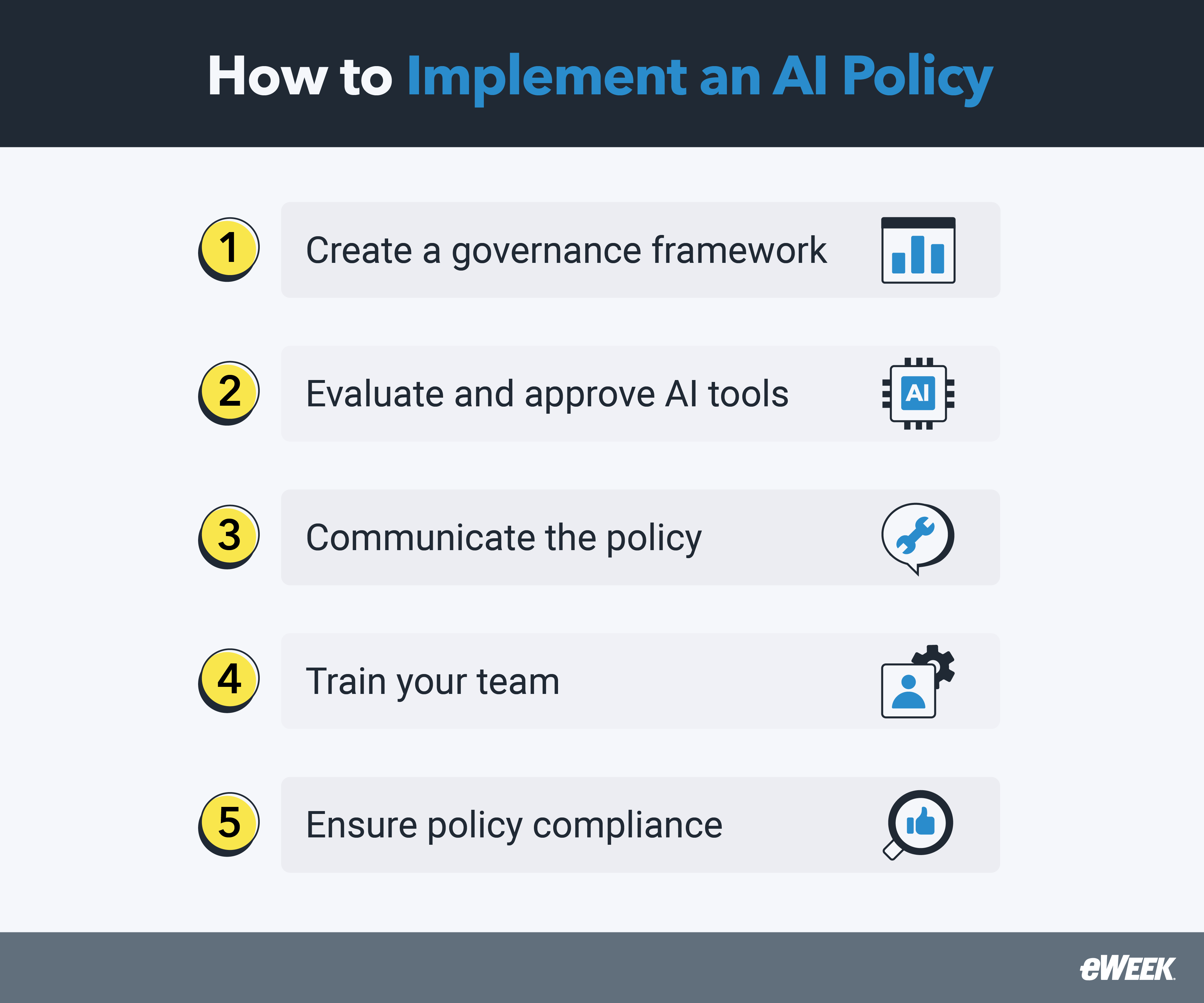Our AI policy template provides a fully realized set of guidelines, principles, and processes to ensure that your business and its employees are using artificial intelligence ethically. By customizing a few key sections, you can quickly implement an artificial intelligence policy that drives your business’s objectives while mitigating the potential risks and unintended consequences of this powerful, emerging technology.
A well-defined AI policy serves as a foundation for the responsible development, use, and governance of AI systems in businesses. This kind of guidance is of increasing importance as AI technologies including generative AI become more widely prevalent across industries. Download our AI policy template below, or read on for more information about each of the individual components as well as guidance on how to complete each section and implement it successfully so that it is clear to understand, easy to follow, and widely adopted.
KEY TAKEAWAYS
A well-crafted artificial intelligence policy includes major components that set clear guidelines, ethical principles, and processes to ensure responsible AI development and use aligned with organizational values. (Jump to Section)
Implementing an AI policy calls for creating a governance framework, evaluating AI tools, communicating the policy, training staff, and ensuring compliance through regular audits and reviews. (Jump to Section)
An AI policy promotes ethical practices, enhances security, prevents bias, and maintains compliance with regulations to protect against legal issues. (Jump to Section)
TABLE OF CONTENTS
Why Your Business Needs an AI Policy
An AI policy guides the responsible use of artificial intelligence and generative AI within your company and minimizes errors that could lead to legal liabilities and reputational damage. Here are some of the most compelling benefits of adopting an AI policy:
- Promotes Ethical AI Practices: An AI policy encourages a culture of responsibility and ethics in AI development, ensuring that AI systems are used for the benefit of all stakeholders and your organization.
- Improves Security: Implementing an AI policy increases the protection of sensitive information and intellectual property from breaches, misuse, and cybersecurity concerns.
- Helps Avoid Bias and Discrimination: A well-implemented AI policy helps detect and prevent algorithmic biases during AI model training to enhance fairness and inclusivity in AI-driven decisions.
- Prevents Legal Issues: By using an AI policy, you establish clear guidelines for AI use, reducing the risk of legal disputes and liabilities.
- Fosters Compliance with AI Regulations: Your business can adhere to industry standards and legal requirements with an AI policy in place to maintain lawful operations and avoid penalties.
- Provides Clear User Guidance: An AI policy offers detailed instructions and expectations for AI usage, aiding employees and stakeholders in understanding their roles and responsibilities.
- Defines Consequences for Violations: Clearly explaining the repercussions of AI policy non-compliance reinforces the significance of adhering to the policy and deters violations.
- Supports Innovation and Growth: Presenting a systematic approach to AI development through an AI policy encourages sustainable innovation and the creation of reliable AI solutions.
Key Components of an Effective AI Policy
An effective AI policy consists of key components that ensure the responsible and ethical development and deployment of artificial intelligence (AI) within your organization. Together, these serve as the foundation for a comprehensive framework that aligns AI initiatives with your organizational values and legal requirements. We’ve included screenshots of these components from our downloadable AI policy template to guide you as you customize it to meet your own needs.
Overview
This section introduces the AI policy, emphasizing your organization’s commitment to ethical AI use and compliance with relevant laws. It allows your organization to clearly communicate its stance on AI ethics and legal compliance from the outset. The Overview also sets expectations for employees and stakeholders, clarifying that adherence is non-negotiable when it comes to AI initiatives. Our AI policy template’s Overview can be used as is, or you may choose specific commitments or initiatives suited to your organization’s mission or industry.
Purpose
This section outlines the objectives of the AI policy, clarifying the need for guidelines to govern AI technologies. It is important for establishing a blueprint that ensures AI usage meets lawful requirements and ethical standards, promoting responsible practices across your organization. We designed the Purpose in our downloadable template to be generally applicable, but it can be tailored to align with your organization’s goals, legal requirements, and industry standards.
Scope
This component defines the applicability of the AI policy, specifying the people, systems, and solutions it covers. By clearly delineating boundaries, it ensures that AI-related actions are governed by the same standards for consistency. The Scope section in our AI policy template is a starting point; customize it as necessary to specify the particular people, systems, and solutions relevant to your organization.
Ethical Principles
The Ethical Principles section articulates your organization’s dedication to responsible and ethical AI practices. This includes subsections for safeguarding fairness, accountability, and privacy. It protects AI systems from discrimination and increases transparency and security. This section in our template is broadly applicable, although adding ethical standards or practices relevant to your organization’s industry can enhance it.
Roles and Responsibilities
This section specifies the roles and responsibilities of individuals and teams involved in AI initiatives. It is necessary for accountability and effective governance, making sure that everyone understands their part in maintaining ethical AI practices. It’s important to customize the Roles and Responsibilities section in our AI policy template to define specific roles and responsibilities within your organization, including titles, particular duties, and the structure of the AI Governance Board, if applicable.
AI Policy Guidelines
AI policy guidelines provide detailed instructions on acceptable AI usage within your organization. This is important for preventing misuse and ensuring that AI technologies, such as generative AI and machine learning algorithms, are used in ways that conform with the company’s ethical principles and legal obligations. Our AI Policy Guidelines section should be customized to include organization-specific instructions on acceptable AI usage—define guidelines for the different types of AI technologies used by your organization.
Policy Violations
The Policy Violations section details the consequences of breaching the AI policy. This is imperative for building a structure of accountability, deterring misconduct, and making sure that all your employees understand the seriousness of adhering to the policy. Our Policy Violations section can generally remain as is, but you might want to customize the types of violations and corresponding disciplinary actions based on your organization’s internal policies.
Reporting Violations
This component encourages reporting any violations of the AI policy and the steps to do so. It empowers employees to raise concerns and bolsters ethical practices and responsibility. Customization of the Reporting Violations section in our AI policy template is necessary to reflect your organization’s exact reporting procedures, including your designated reporting channels, contacts, and processes for handling reported violations.
Exceptions
Exceptions clarify any circumstances under which deviations from the AI policy may be permitted. This is necessary for providing flexibility while keeping the integrity of the policy, ensuring that unique situations can be addressed appropriately. You should adjust the Exceptions section in our template to present the situations in your organization where exceptions are allowed. Provide relevant examples and clarify the approval process.
Policy Reviews
This section outlines the process for regularly evaluating and updating the AI policy. It is important for maintaining the policy’s relevance and effectiveness in light of evolving technologies and industry regulations. You can customize this section in our AI policy template by changing the frequency of reviews in who is responsible for conducting them in your organization.
Acknowledgement
The Acknowledgement section requires your employees to confirm their understanding and acceptance of the AI policy. It ensures that all staff are aware of the policy and its implications, upholding a culture of compliance and ethical responsibility. The Acknowledgements section in our AI policy template is applicable to different industries, but you may also consider including additional methods for acknowledgement, like training completion certificates.
Step-by-Step Guide to Implementing an AI Policy
Developing an artificial intelligence policy is just the first step—a clear, systematic approach to implementing it helps make it actionable, encouraging adoption and building trust. Successfully implementing an AI policy involves several steps and may involve the participation of multiple people across departments.
Create a Governance Framework
Develop a structure to manage and oversee AI usage in the organization, clearly outlining roles, responsibilities, and decision-making processes. Create an AI Governance Board comprising department heads, legal advisors, compliance officers, ethics specialists, and senior IT security managers to champion the project and shepherd it through. Consult with experts in AI, law, ethics, and compliance, and engage with stakeholders from various departments to make sure all perspectives are taken into account.
Evaluate and Approve AI Tools
Establish a process for assessing and approving AI tools. Form a sub-committee of the AI Governance Board to manage the evaluation process and keep thorough records of the findings and decisions. The committee must check the AI tools’ alignment with ethical standards by evaluating functionality, potential biases, and adherence to legal and regulatory requirements. Gather comprehensive insights from AI developers, ethicists, legal advisors, and end-users.
Communicate the Policy
Disseminate the AI policy to all employees and stakeholders. This boosts awareness and compliance through various communication channels, such as internal emails, training sessions, and policy documents. Coordinate with the communications team to craft clear messages, and work with HR and training departments to organize informative sessions to ensure that everyone is aware of the AI policy and its importance.
Train Your Team
Provide in-depth training for the board, staff, and relevant stakeholders to make sure they understand the AI policy and its implications. Develop training programs that cover the AI policy, ethical guidelines, compliance requirements, and practical applications. Tap into experts in delivering the training and offer continuous education as needed, creating a culture of ethical AI practices.
Ensure Policy Compliance
Regularly conduct audits and reviews to monitor adherence to the AI policy. Use compliance tools and technologies to track AI usage and pinpoint areas for improvement. Involve internal auditors and compliance officers for this process, and bring in external auditors for impartial evaluations. This will ensure that your organization’s AI initiatives are trustworthy and reputable.
Expert Insights on AI Policies
AI industry experts stress the need for proactive policies for the responsible development and deployment of AI technologies. In its relatively short existence, artificial intelligence has attracted a lot of attention—not all of it positive—and already raised a number of legal and ethical concerns that companies need to make sure they’re aware of and addressing before they become problems.
“People can’t be left to use AI at work in whatever way they feel like without some clear guiding principles to follow,” said Nash Squared CIO Ankur Anand, who added that an AI policy is “foundational” for organizations. A recent Pulse survey from Anand’s company revealed that 42 percent of tech leaders said their organizations currently have an AI policy in place, while another 38 percent plan to implement one. This reflects a growing recognition among industry leaders of the need for structured AI governance.
A recent Science magazine article titled “Managing Extreme AI Risks Amid Rapid Progress,” coauthored by two dozen AI experts, outlined a number of specific policy recommendations for businesses to take. These include substantial investments in AI safety research, the establishment of international standards, and licensing requirements for advanced AI systems, among others.
Similarly, Open Philanthropy’s senior program officer for AI governance and policy Luke Muehlhauser highlighted the urgent need for robust AI policies to mitigate risks posed by AI in a blog post on the foundation’s website. Muehlhauser argued that concerns among experts regarding potential catastrophic outcomes, including human extinction, justify ambitious regulatory measures, despite the tendency of over-regulation.
Bottom Line: Use Our AI Policy Template to Balance Innovation and Safety
Our AI policy template will help you set the parameters for your organization’s approach to AI, empowering you to embrace the technology while exercising caution. It specifies both the appropriate uses and limitations of your enterprise AI systems. It is built to foster responsible and ethical AI use in your business.
However, keep in mind that an AI policy’s true value lies in its implementation—the policy that you meticulously crafted on paper must be put into practice with equal care. Make sure that everyone in your organization—from department heads to end-users—understands the importance of adhering to the policy, and hold people accountable when they do not.
Read our article on 15 Generative AI Enterprise Use Cases to find out how generative AI can boost your business.
